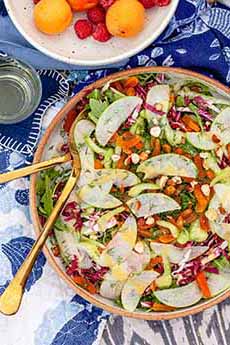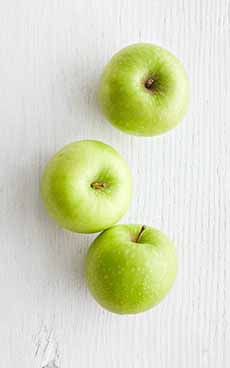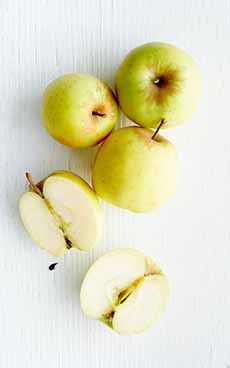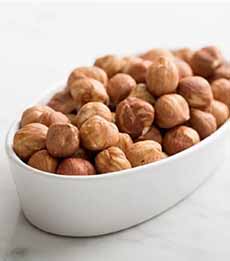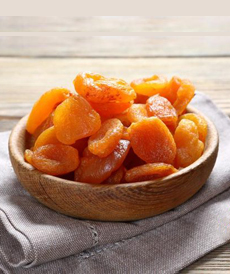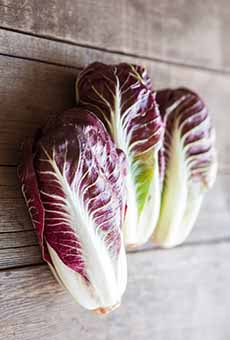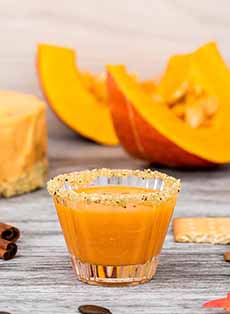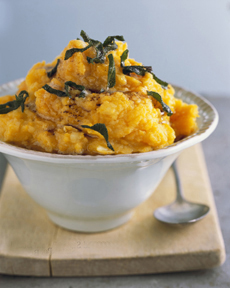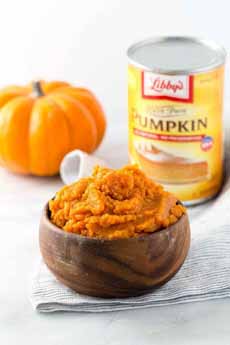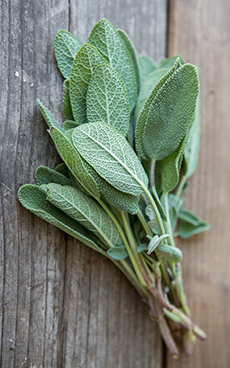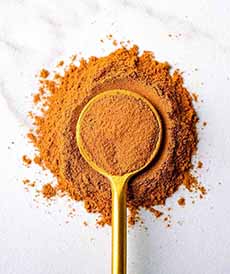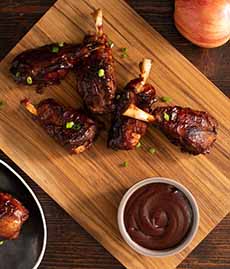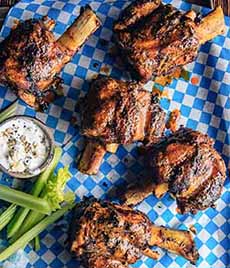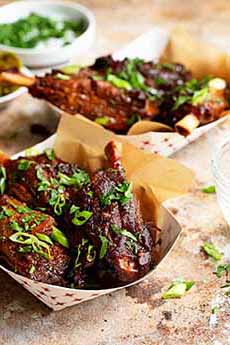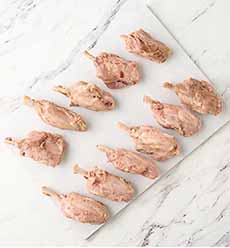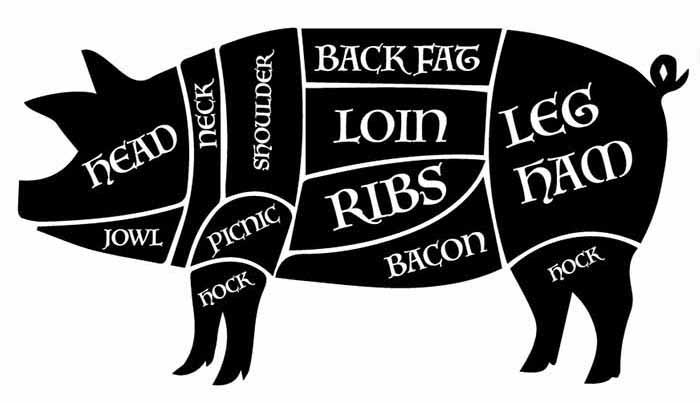|

[1] Carignan wine has a dark red color (photo © Tribella Wine).
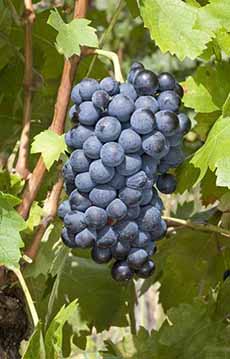
[2] A cluster of Carignan grapes (photo © Vins Rhone).
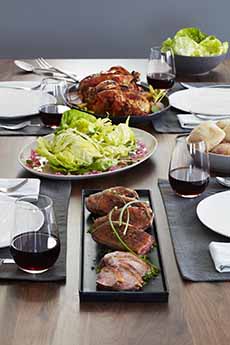
[3] Carignan is a great pairing with poultry. In the photo, it’s roast duck; but it can also be the Thanksgiving turkey (photo © Dean & DeLuca).
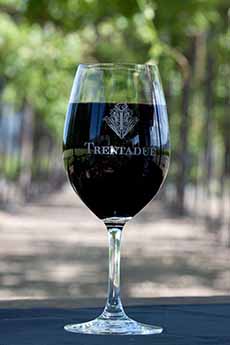
[4] A glass of Carignan from award-winning Trentadue Winery (photo © Trentadue).

[5] Serve Carignan with salumi, the Italian term for charcuterie (photo © Oz Restaurant & Bar | Arlington, Virginia [permanently closed]).
|
|
October 26th is National Carignan Day. What’s Carignan, you may ask?
Carignan (CARE-in-yen), a medium-bodied, medium-tannin red wine from southern France, has long been known as a value wine—i.e., a low-quality wine grape used for bulk wines.
The high-yielding grape has long been a major blending grape, adding its fruitiness and color to other wines.
But in recent years, Carignan has become known for its ability to make quality wines. A new generation of winemakers is reinvigorating old vineyards and making tremendously rich, red fruit-driven wines.
Take a moment to learn about today’s Carignan, a great food wine.
If you’re a fan of lighter-style Zinfandels, Merlot, or Côtes du Rhône, then pick up a bottle of Carignan.
Ideally, it should be a wine made from old vines (vieilles vignes), where the productivity of the grape clusters is low and the concentration of flavors is high. The wines will burst with fruit and will be smooth on the palate thanks to lighter tannins.
> The history of Carignan is below.
MAJOR CARIGNAN PRODUCING REGIONS
Outside of widespread planting in the French Midi† (southern France, including Languedoc-Roussillon), Carignan is grown in:
Northern Spain, where it’s called Cariñena or Mazuelo
Sardinia, Italy, where it’s called Carignano del Sulcis
Africa: Algeria, Tunisia, Morocco
The U.S., particularly in California and Texas, where it’s spelled Carignan or Carignane
Plus: Algeria, Chile, Croatia, Cyprus, Israel, Malta, Mexico, Portugal, Turkey
Below, we have 10 award-winning Carignan wines from the U.S.
PAIRING CARIGNAN WINE & FOOD
Why is Carignan a great food wine? Because of its medium body, it pairs with bold-flavored dishes as well as lighter ones. And the flavor is balanced without bitter tannins.
Its fruit-forward, with red fruit and baking spice flavors that pair with the spices in almost any cooked dish.
On the palate, with its bold red fruit, pronounced acidity, and earthy-meaty notes, Carignan is an excellent match with:
Beef brisket, lamb, steak
Herbs/Spices: allspice, cinnamon, Chinese five-spice, clove, coriander, cumin, dill, juniper berry, Madras curry, oregano, ras el hanout, red pepper flakes, rosemary, soy sauce, thyme, za’atar
Cheese/Dairy: Basque cheese, farmer’s cheese, Gouda and aged Gouda, Parmigiano-Reggiano, yogurt, young Manchego
Cured Meats: bacon, bresaola, coppa, soppressata
Poultry: chicken, duck, squab, turkey (especially dark meat and smoked turkey), quail
Roasted pork, including pork shoulder
Spicy dishes in general
Spicy meat dishes, from lamb meatballs to sausages
Vegetables: butternut squash/kabocha squash/pumpkin, eggplant, grilled onions/shallots/garlic, roasted leek, roasted red pepper, shiitake and other mushrooms, tomato
Plus: dried cranberries, wild rice
And since we’re approaching the holiday season as of this writing and anticipating that roast turkey, Carignan is a wine that can join the traditional Thanksgiving wine lineup of Beaujolais (Gamay), Châteauneuf-du-Pape, Grenache*, Pinot Noir, and Zinfandel.
WHICH CARIGNAN SHOULD YOU BUY?
Your wine store clerk can show you what’s available in the store. But for the best American Carignans, here are the winners in the 2023 San Francisco Chronicle Wine Competition:
Jessie’s Grove Winery 2019, Lodi AVA, Best of Class Medal, $45
Favalora Vineyards Winery 2020, Contra Costa County AVA, Double Gold Medal, $34
Goldschmidt Vineyard 2019 Gracepoint Vineyard, Dry Creek Valley AVA, Double Gold Medal, $50
Favalora Vineyards Winery 2020, Contra Costa County AVA, Double Gold Medal, $38
El Vaquero 2019 One-Eyed Charlie, Sandy Lane Vineyard, Contra Costa County AVA, Double Gold Medal, $36
Saini Vineyards 2021, Dry Creek Valley AVA, Old Vine, Gold Medal, $50
Indivisible 2018, Mendocino AVA, Gold, $28
Favalora Vineyards Winery 2017 Old Vine, Contra Costa County AVA, Silver Medal, $35
Trentadue 2020 Estate Old Vines, Alexander Valley AVA, Silver Medal, $28
Carol Shelton Wines 2018 Oat Valley Vineyard, Alexander Valley AVA, Silver Medal, $30
Pedernales Cellars 2019, Texas High Plains AVA, Silver Medal, $40
La Vie Dansante Wines 2019, Santa Clara Valley AVA, Bronze Medal, $42
Of course, you can find affordable bottles for as little as $15.
A tip from Wine Folly: Carignan can smell oddly meaty upon first opening a bottle. If yours has a meaty aroma, decant it for at least an hour.
THE HISTORY OF CARIGNAN
The Carignan grape has a long and storied history within the Mediterranean region, particularly in Spain and France.
|
Ampelographers‡ believe that the grape likely originated in Cariñena, Aragon, northern Spain, as the grape is called Cariñena.
They believe that Carignan is likely a very old variety due to its widespread plantings and the proliferation of numerous different names that give testament to the grape’s long history in different wine regions [source].
Carignan was introduced to France, specifically the Languedoc-Roussillon region in the southern part of the country, in the 12th century [source].
It reached Sardinia sometime between 1323 and 1720 when the island was under the Spanish influence of the Crown of Aragon [source].
During the late 19th and early 20th centuries, Carignan saw widespread planting in the Languedoc-Roussillon region. It was a prolific vine that produced high yields and was a reliable source of red wine, especially during challenging growing conditions.
For much of the 20th century, Carignan was used to produce inexpensive bulk wines. This mass production often resulted in low-quality, diluted wines.
Carignan was historically a component of the Rioja red wine blend. The grape’s prominence in France hit a high point in 1988 when it accounted for 167,000 hectares (410,000 acres) and was France’s most widely planted grape variety (used for blending and bulk wines).
By the late 20th century, Carignan had gained a reputation for producing wines lacking complexity and finesse. Carignan’s popularity declined, and many vineyards were uprooted or replaced with other grape varieties.
In more recent years, there has been a revival of interest in Carignan, particularly in old-vine Carignan vineyards. Winemakers have recognized the potential of old, low-yielding Carignan vines to produce high-quality wines with depth and character.
When carefully tended and harvested from older vines, Carignan can yield wines with flavors of dark fruit, spice, and good acidity. Beyond serving as a blending or bulk-wine grape, Carignan is also standing on its own merit, with single varietal bottlings of 100% Carignan.
In France, regulations have been put in place to limit the planting of new Carignan vines in an effort to focus on quality over quantity. Old-vine Carignan, especially in the Languedoc region, is highly prized.
In the U.S., there’s plenty of Carignan for blending, but with the changing dynamics of the wine industry, the grape is also producing high-quality wines like those mentioned above.
Carignan as a fine varietal wine is on a growth trajectory in the U.S. and elsewhere. It can make interesting and distinctive wines, and just as important, it’s hardy and prolific.
__________________
*Carignan vs. Grenache: Carignan is a medium-body wine while Grenache is medium-full bodied wine. Both are fruit wines but have different flavors. The Carignan flavor profile is known for baking spices, with a hint of licorice and cured meat. The Grenache flavor profile is red fruit—black cherries, raspberries, and strawberries, with hints of cinnamon and anise.
†Southern France, also known as the south of France or colloquially in French as le Midi, is a defined geographical area consisting of the regions of France that border the Atlantic Ocean south of the Marais Poitevin, Spain, the Mediterranean Sea, and Italy.
‡Ampelography is the field of botany concerned with the identification and classification of grapevines.
CHECK OUT WHAT’S HAPPENING ON OUR HOME PAGE, THENIBBLE.COM.
|
